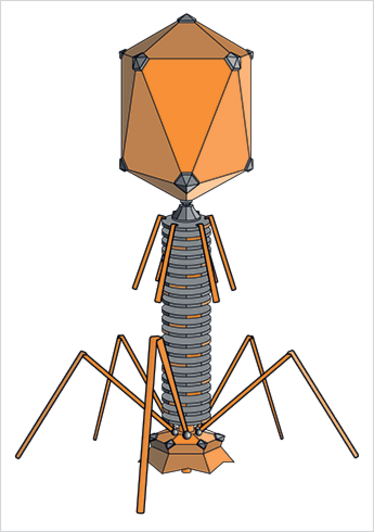Battle of the Superbugs
Can phage endolysins revolutionize the way bacterial infections are treated – and prevent drug resistance?
We discussed the problem of antibiotic resistance at length in our previous two issues – and while several companies are rising to the challenge of developing new antibiotics, some are taking a different approach entirely. Micreos, a biotech based in the Netherlands, has developed what it calls a “bacteria-killing enzyme”: Staphefekt, directed against Staphylococcus aureus, including MRSA. It is produced by a bacteriophage, a virus that targets this bacterium. It has just become available as an over-the-counter treatment for S. aureus-related skin conditions like eczema, rosacea and acne (Gladskin), but the company is looking to conduct clinical trials and eventually have the product prescribed by physicians to supplement antibiotic treatment.

“In nature, phages infect the bacterial cell in order to multiply. After new phages have been assembled, the bacterial cell wall is destroyed by phage enzymes called endolysins to allow the newborn baby phages to be released. With Gram-positives, endolysins work from the outside as well,” explains Bjorn Herpers, a clinical microbiologist who tested the drug at Public Health Lab, Kennemerland. “Staphefekt is composed of two parts of naturally existing phage endolysins: one part is best at specifically binding S. aureus, the other part is best at disrupting its cell wall.”
One of the main advantages of the technology is that it can eliminate bacteria without causing drug resistance. As the release of the new phages from the bacterial cell is a part of the phage lifecycle, natural selection has yielded endolysins that target highly conserved structures in the bacterial cell wall that cannot easily be changed. According to Herpers, if bacteria could develop resistance to current endolysins, they would have done so already.
However, this doesn’t mean the war on superbugs is over. Endolysins are large molecules that cannot enter tissue cells. Since they also harbor natural epitopes, immunogenicity could come into play with systematic administration.
“For local application, for example in burn wounds, surgical wounds, or infected implants, this is much less of a barrier,” says Herpers. “The introduction of the first endolysin for human use marks the realization of a technological platform for the development of more endolysins and other fields of phage technology, with lots of potential to target other bacteria, like Clostridium difficile.”
The company has also developed an aseptic liquid formulation suitable for local administration in research settings. The next step will be registration for use, and the team is also working on slow release systems for conditions that require continuous local treatment, such as infected implants.

Making great scientific magazines isn’t just about delivering knowledge and high quality content; it’s also about packaging these in the right words to ensure that someone is truly inspired by a topic. My passion is ensuring that our authors’ expertise is presented as a seamless and enjoyable reading experience, whether in print, in digital or on social media. I’ve spent fourteen years writing and editing features for scientific and manufacturing publications, and in making this content engaging and accessible without sacrificing its scientific integrity. There is nothing better than a magazine with great content that feels great to read.



















